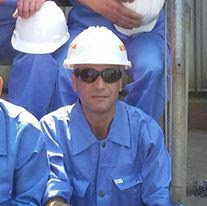Torque , Couple , Work Done and Power Transmitted
Torque , Couple , Work Done and Power Transmitted
Introduction
Torque is the turning moment of a force. When a force produces the rotation of a body without translation motion, there must be a second force acting upon the body equal and opposite to the first so that the resultant force is zero. That is, the forces are in equilibrium.
Couple and Torque
the spanner and nut shown in Fig. 1. When a force F1 is applied to the end of the spanner, an equal and opposite parallel force F2 occurs at the nut. If this were not so, there would be motion of translation in the direction of force F1. When two equal and opposite forces act on a body they are said to form a couple.
 |
| FIG 1 |
Torque (T ) = magnitude of the applied force (F1)×length of the torque arm (d)
T= F × d (N.m)
Where:T = torque (N.m)
F = force (N)
d = moment arm (m)
Work Done and Power Transmitted
a pulley wheel of radius r metres attached to a shaft and a force F newtons applied to the rim at point P as in figure 2 .and the pulley wheel having turned through an angle 𝜃 radians as a result of the force F being applied. The force moves through a distance s
 |
| FIG 2 |
But:
s = r×𝜃 (m)
Therefore:
work done = r𝜃 × F = Fr ×𝜃
But
torque T= Fr
Therefore:
work done = T× 𝜃 (N.m or J)
Work done by a torque = torque × angle of rotation in radiansAverage power = work done / time taken = (T𝜃 ) / time taken for a constant torque T
But
angle / time taken = angular velocity 𝜔 rad/sec
𝜔 = 𝜃 / t
Therefore
power P = T× 𝜔 watts
Angular velocity, ω = 2 𝜋n rad/s
where
n is the speed in rev/s
power P = 2 𝜋 n T watts
Power Transmission by Belt Drives
read from link : power-transmission-by-belt-drives
Labels: MECHANICS




0 Comments:
Post a Comment
thanks for your visit
Subscribe to Post Comments [Atom]
<< Home